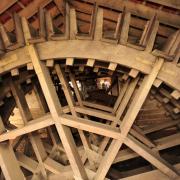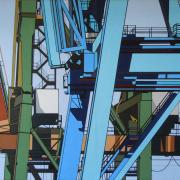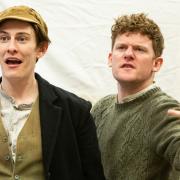Frances Hopewell-Smith goes into the woods to experience the thrill of husky racing. Photos: Chris Wellstead

One of the privileges of writing for Suffolk magazine is the opportunities I get to see and do special things. I’ve been on a potato harvester, behind the scenes at a London theatre, spent time with a falconer and eaten at the best places in the county.
I’ve learned about deer, rapeseed oil, English Longhorn beef cattle and raw milk production. But husky racing is without doubt one of the more unusual subjects to come under my pen.
To catch the most local meeting of the season I get to Rendlesham woods near Woodbridge early one Saturday morning. It is raining unremittingly, windscreen wipers on superfast and floodlike puddles punctuating the road. Following the discreet BSHRA (British Siberian Husky Racing Association) signs my car squelches into one of the many woodland tracks.
It is eight in the morning but already the verges are lined with vans, cars and trucks and even some tents. As I open the car door the noise is overwhelming, a mighty barrage of barking and howling the like of which I’ve never heard. Making my way through the mud and rain I pass strings of dogs in special shelters or in the backs of the vans.
It is a thoroughly damp and miserable morning but everyone seems in high spirits and they shout to each other over the unbelievably loud and non-stop noise of hundreds of dogs.
My contact today is one of the organisers, Steve Rooke, and I eventually find him in the registration tent, dealing with a queue of dripping husky racers waiting to get their start times and competitor numbers. It’s obviously not a good time to talk so I sidle up to a woman by a van with ten dogs in it and engage her in conversation.

She’s been a husky fan for years, she says, and loves the breed, although they’re not easy to look after, not really a surprise since they are probably more closely related to a wolf than most dogs. They love to run, need loads of exercise, are rarely, if ever let off the lead and enjoy the company of their fellow pack members.
My new friend tells me that this three-mile course through the woods is one of the best in the country and they all look forward to coming here. They certainly must if some of them are prepared to camp in torrential rain, but she assures me that the camaraderie and support of the husky racers is worth the discomfort.
They do it for the companionship as much as anything, and of course the dogs love and live to run.
The races are a series of time trials with divisions for eight, six, four and two dogs. There’s even a class for a single dog and they are all harnessed to lightweight customised bikes (rigs) with three or four wheels and a small platform to stand on. It takes skill to get all the dogs harnessed in the right order to get the best out of them and, believe me, the riders have to be as fit as fleas to control the full force of racing huskies.
At the start gate handlers hold each dog, all of them (the dogs not the handlers) barking at full volume. On cue the handlers let go and the dogs leap away, immediately quiet and running flat out.
In seconds they are out of sight round the first bend and I wonder how the rider is brave enough to be pulled along at frightening speed by a team of dogs, with no sure way of steering them. Or indeed stopping. I’m told that in perfect conditions, not today obviously, the dogs can reach nearly 30mph. No wonder the riders wear helmets.

Today, as the rain continues to pour, the riders are not having the best time. They arrive at the finish so plastered with mud that they are almost unrecognisable.
Removing their goggles, two patches of skin are revealed in an attractive all-over body mud pack. Camcorders attached to riders’ helmets are mud-covered too and it’s hard to see how they’ve actually got anything worthwhile on film, apart from unidentifiable brown splodge.
The dogs meanwhile, equally muddy, are rubbed down and given water and some treats. There’s a lot of laughter, sharing of stories and comparing of timings for the important placings.
The season runs from November until mid March, timed to cause least disruption to other activities and make the best of the cooler weather wherever the races are taking place. Unwary dog walkers and ramblers who come across the event in full swing are astonished by the spectacle. It is a wonderful phenomenon and there are an incredible 150 teams of dogs racing today.
At last Steve has some time to talk and tells me how the dogs, who race from the age of 12 months, can run flat out for nearly ten minutes over this course.
Their close relationship to the wolf, with their arctic colouring and cool blue eyes, makes them fascinating and demanding ‘pets’.
The BSHRA, Steve tells me, is not a membership organisation but a loose association, a nicely informal system which works well for these madcap racing dog owners who rely so much on one another’s support.
The dogs are magnificent, handsome animals and seeing them doing what they love best is heart-warming. It’s not surprising that they arouse such devotion and fervour even though, or maybe because, they don’t fit into the stereotypical image of doting puppy-dogs.
We watch the last teams reach the finish line, now a quagmire, the steam rising from the panting dogs and exhausted riders. The rain continues to pour and like everyone else, I’m drenched and muddy.
With no-one to rub me down and put me in a clean, dry coat, I go back to the car and head for home.
Information at www.huskyracing.org.uk
__________________



























